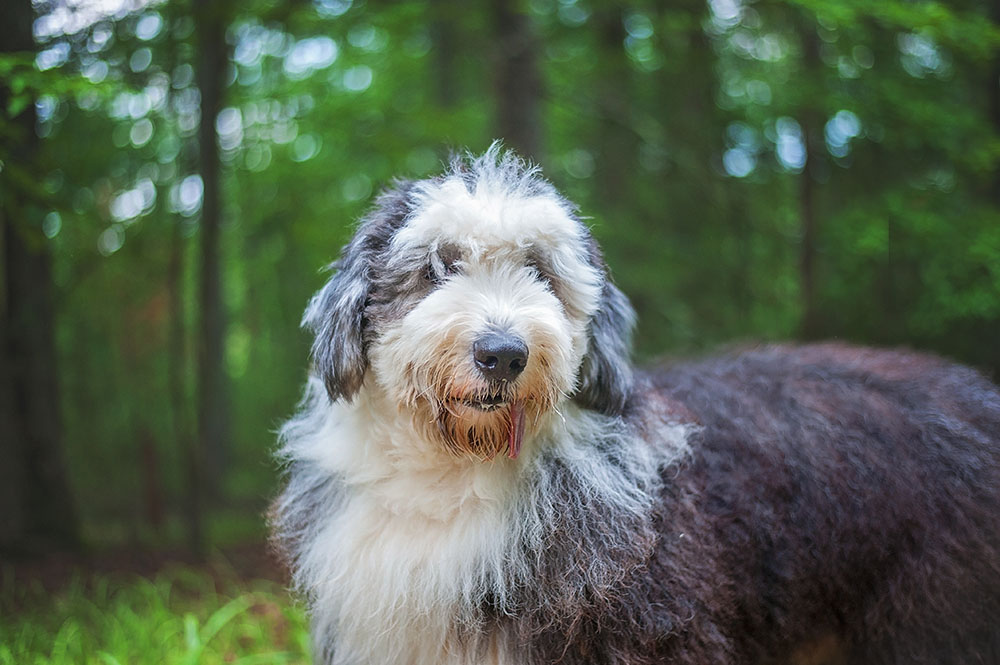Breed Profile – Old English Sheepdog
04/08/2017
The Old English Sheepdog, a breed of uncertain origin, is the focus of our latest breed profile. It’s origin may be uncertain, but we do know that its distinctive coat is going to require a lot of upkeep. Grooming this breed is practically a full time job!
History of Breed: The origin of this breed is hotly debated in dog circles. Some say that the previously customary docking of their tail could have been a tax avoidance tactic, because drover’s dogs, which were also docked, were tax exempt. However this theory would cast doubt over their title of ‘sheepdog’ since drover’s dogs drove cattle not sheep. The fact that Old English Sheepdogs were docked at all is rather strange, as sheepdogs require their tails to aid balance during their athletic movements. Some like to count them as a native breed, with the Bearded Collie and Scottish Collie counted amongst its ancestry. Its similarity to the Ovtcharka or South Russian Shepherd Dog cannot be ignored though. The Old English Sheepdog’s characteristic appearance has made it popular for media use, most famously as the Dulux dog.
Life Expectancy: Over ten years.
Size: A large dog with a height range of 56-61cm and a weight range of 27-41kg.
Features: Old English Sheepdogs are famous for their ‘shaggy dog’ appearance. Puppies are actually born with a black and white coat, which sheds and is replaced with the characteristic adult coat. The coat has a water resistant undercoat and long, thick overcoat in any shade of grey, grizzle or blue. Thick hair also covers the head, neck and ears, obscuring the usually dark eyes. Potential owners will need to dedicate lots of time to keeping the coat groomed and free of debris. Strong, sturdy and muscular, the breed has a ‘bear-like roll’ when walking and a straight, driving gait when running.
Energy Levels/Exercise Required: The biggest of the British sheepdogs, the Old English Sheepdog requires plenty of exercise – typically more than two hours per day. It has the stamina to carry out a full day’s work on the hills or fells and natural herding instincts. Therefore, exercise that stimulates them mentally as well as physically is essential. As a high energy dog, they need a nutritionally balanced dog food that provides all the energy and nutrients to keep them going all day. The Dr John range caters specifically for working dog breeds and contains a bone and joint complex for optimum health. Dr John Titanium is a great transition feed for junior and adolescent dogs. Whilst Dr John Grain-Free Chicken and Potato is a good alternative for those dogs with sensitive stomachs.
Potential Health Problems: Unfortunately, cancer is a common cause of death for the Old English Sheepdog, whilst thyroid problems and diabetes can also be a cause for concern. Hip dysplasia is a common problem in this breed. Too much exercise and jumping from heights in puppyhood and carrying excess weight can all worsen this inherited condition. Feeding to condition with a good quality dog food is the best way to maintain a healthy weight. Eye problems, such as cataracts, glaucoma and entropion, are something for potential owners to be aware of. As with all breeds with long, thick coats, exercise in hot weather can lead to heatstroke.
Temperament: Old English Sheepdogs are never nervous or aggressive, but will be protective of boundaries and owners. A highly intelligent breed, they are also faithful, trustworthy and courageous. They need firm but positive training from an owner who takes time to understand the breed.
Family Dog/Child Friendly: Despite being a working breed, the Old English Sheepdog makes a great pet with the appropriate handling and training. With appropriate socialising when young, they are also child friendly. They have a tendency to try to ‘herd’ children and people. Therefore, as with all dogs, supervision with toddlers and small children is essential. Their love of fun and games and high energy makes them happiest in a household that participates in outdoor activities. A large house with plenty of outdoor space to run around would be perfect.
Likes: People, companionship, exercise, herding, games.
Dislikes: Solitude, lack of exercise.



